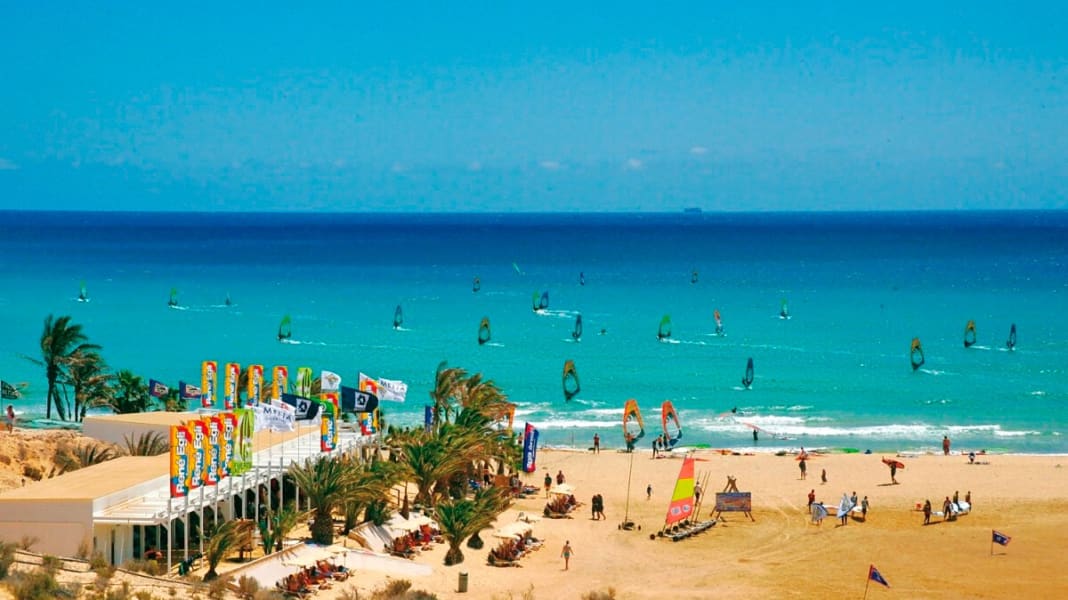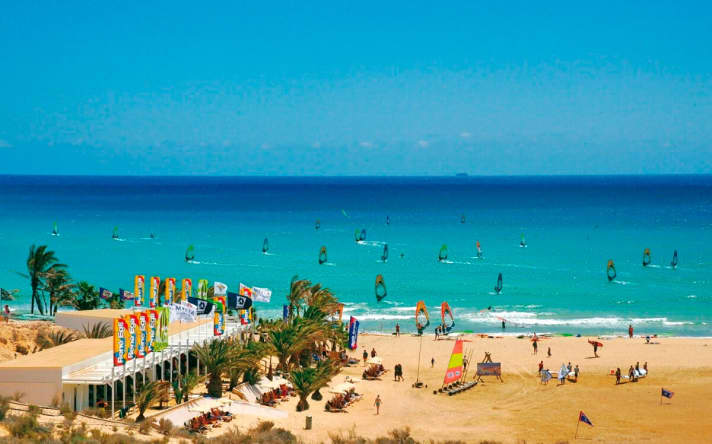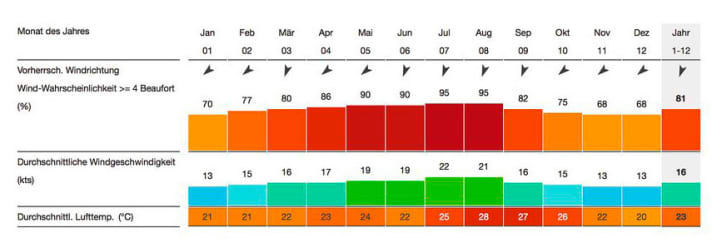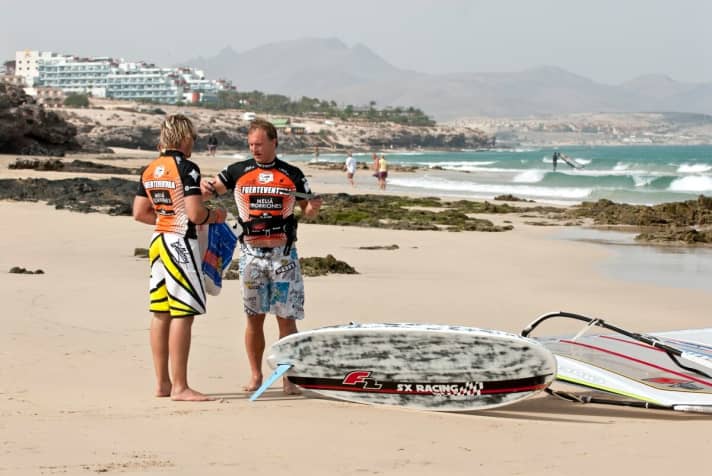

Located to the west of Morocco, but still part of Spain, are the Canary Islands. They all benefit from the trade wind zone in summer, which provides a regular north-easterly wind. Costa Calma is located on Fuerteventura, the north-easternmost of the Canary Islands and is known as a surfing mecca among windsurfers and kiters. Everyone gets their money's worth here: beginners and intermediates can practise in the shallow, shallow lagoons in the mornings when the wind is weaker, while advanced surfers can unpack their small sails in the afternoon and either freestyle in the lagoon or slash small waves behind the sandbank. Freestylers and strong wind fans get their money's worth in July and August.Beginners will find top conditions here all year round.
General information: After just a 4.5-hour flight, you're already on the dry, always sunny island in the middle of the Atlantic. From the airport, it's a good 1.5 hours by car or transfer to Costa Calma. Especially in the southern part of the island you will find a huge selection of hotels and flats - from low cost to high life, from party to family-friendly - there is certainly something for everyone. With air temperatures between 26°C in summer and 20°C in winter, you are well equipped here with summer clothing and a warmer jumper for the evening hours. Even if the air is warm, you should always pack a long wetsuit.
Wind:In general, the Canary Islands are ventilated by the north-east trade winds in the summer months. In the winter months, this trade wind zone then lies over the Canary Islands. In the south-east of Fuerteventura, 5 to 10 minutes by car south of Costa Calma, are the spots Sotavento and Risco del Paso, where there are also lagoons. Here, a thermal is created that blows offshore and is strengthened by a guard rail effect. The wind usually increases during the course of the day, reaching gliding strength from around 12 noon onwards and then increasing further during the afternoon before dying down again at sunset. In July and August in particular, there is hardly a day without a gliding wind. If you look at the Wind statistics from Windfinder or of the Surf & Action Company it becomes clear that more and more gliding wind days are added from around March (or even better from May) until the maximum in July / August. At the beginning of September, these thermals then break down, but this does not mean that there is no more wind: even in the least windy months of November to January, the wind still reaches gliding wind strengths (more than 4 Beaufort) every 2nd to 3rd day. Beginners and intermediates in particular can therefore surf here all year round in pleasant temperatures.

Spots, surf stations and some of the accommodation: There are three spots in the immediate vicinity of Costa Calma: Costa Calma directly, a little further south is Sotavento and a little further along the coast to the south is Risco del Paso. The special thing about these three spots and their respective centres is that you can reach them all without a car, as there are regular shuttle buses from Costa Calma, some even from some of the hotels directly to the centres.
Directly in Costa Calma you will find the ION Club Costa Calma formerly Club Mistral. Within walking distance of most hotels in Costa Calma, you will find a very special level of comfort at this centre: Non-surfing enthusiasts can make themselves comfortable in one of the many cafés and restaurants, stroll through the many shops in the village or, on some days, through the market. At the centre itself, you can expect the latest equipment from the NorthSails and Fanatic brands to the usual ION Club standard. The wind is a little gusty here in the first 100 metres, behind which there is a large freeride area.
A little to the south is the René Egli Station In addition to the freeride area on the open sea, you can also train in the lagoon, depending on the tide. You will also find the latest equipment here, this time from the brands Neilpryde, JP and Starboard. The PWA organises a tour stop here every year in July / August. Action on the water is then guaranteed.

The larger ION Club Station is located at the "Risco del Paso" spot and is also known as Centre 2 and is usually used for training in the lagoon. Depending on the tide, the water here is shallow. If the lagoon is too shallow, freestylers can let off steam here for an hour or two in perfectly flat water (in the remaining navigable "channels"). In the open sea, behind the sandbank, small but clean waves run in on many days.
You can find even more information and a selection of accommodation as well as more detailed descriptions on the pages of sun+fun and the Surf & Action Company - You can also book the entire trip there.
Alternatives in the neighbourhood: In Sotavento and Risco del Paso, water sports really take centre stage. At both spots, however, you will of course also find a comfortable infrastructure with freshwater showers, toilets, changing rooms and a café/bar. If you are really looking for a change of pace and want to stroll through the shops during the day, you should head straight to Costa Calma. You can also party in a club there on some evenings and there are a few bars and restaurants to choose from. However, there is definitely no colourful nightlife here. The surf spots are located in the north and west of the island, and about a 2-hour drive north of Costa Calma there is a huge dune landscape that is worth a short hike. To the west of the toruist "metropolis" of Corralejo in the north is virtually no man's land. A gravel track runs along the north coast and one surf spot follows the next, with small fishing villages scattered in between. South of the southern tourist "metropolis" of Jandía, you can spend the whole day driving on a gravel track through breathtaking no man's land to the southern tip of the island. There are also some remote surf spots here. So if you are flexible with your car, you can discover something new in every corner of the island. The only thing you won't find is the colour "green" away from the golf courses.

Arrival: The windsurfing town of Costa Calma is just 1.5 hours' drive south of the airport. A comfortable country road leads there, mostly with breathtaking views, along the coast. Fuerteventura is served by flights from almost all German airports, and after a good 4.5 hours flying time you are already in summer.
Want to discover the other beaches and spots on Fuerteventura? Then click here here You can find detailed travel reports with lots of information about the spots along the coast in the Spain area in the Travel centre of the surf magazine.

